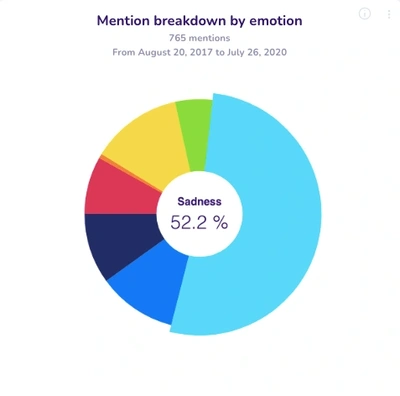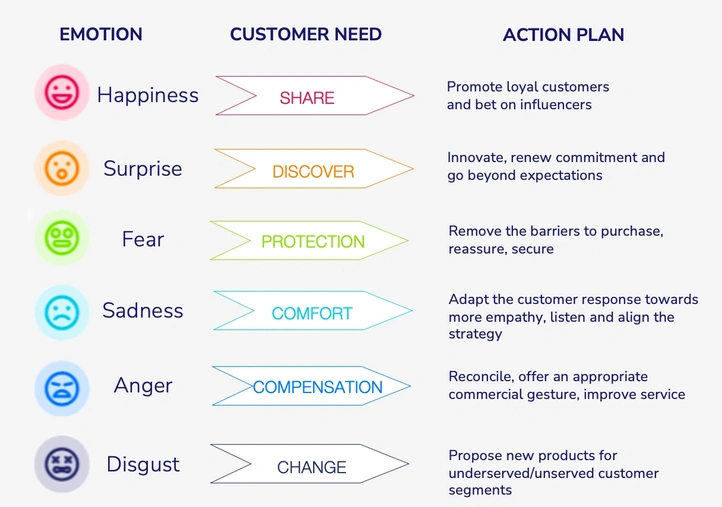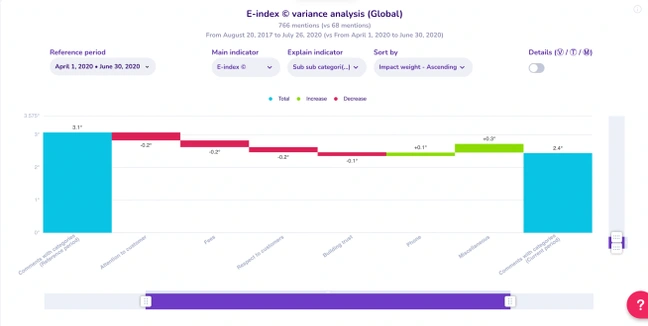Comparison: Emotional Analysis vs Sentiment Analysis - Q°Emotion
Published on May 23, 2022 - Updated on November 05, 2024
Emotional Analysis vs. Sentiment Analysis: Which Approach to Improve the Customer Experience?
Automatic semantic analysis tools are becoming increasingly diverse and now offer two main approaches: sentiment analysis and emotional analysis. Although similar in many respects, these two types of semantic analysis have some fundamental differences, which are essential to understand when choosing the one that best meets your objective: monitoring e-reputation, improving the customer experience, or optimising user journeys. In this article, we compare the two methods to help you select the most appropriate one.
What is the difference between Sentiment and Emotion in Semantic Analysis?
To fully understand these two approaches to automatic semantic analysis, it is important to differentiate between sentiment and emotion.
Sentiments are indicators of opinion, expressed by words, verbs, adjectives, emojis or hashtags. They convey a positive, negative or neutral judgement. Sentiment analysis identifies these judgements to classify overall opinions in a polarised direction.
Emotions, on the other hand, reflect intense and unavoidable affective states. The six primary emotions (joy, surprise, fear, sadness, anger, disgust) influence consumer decisions and play a crucial role in the perception of a brand or product. Emotional marketing, used by many brands, exploits these emotions to build customer loyalty.
1) Sentiment Analysis: For rapid E-Reputation monitoring
Sentiment analysis is widely adopted by companies wishing to monitor general opinion online and on social networks. It classifies comments into positive, neutral or negative sentiments, often supplemented by a trust score.

Functioning and Algorithms of Sentiment Analysis
Behind the results, a pre-processing step will first clean and standardize the words. The most common techniques will automatically lowercase, remove punctuation, numbers and empty words, special characters can be converted, the word family analyzed, etc.
Once the pre-processing is complete, the automatic sentiment algorithms can be classified into 3 parts:
- machine-learning: this approach uses a machine learning technique and various features to build a classifier that can identify the text that expresses a sentiment. Nowadays, machine learning methods are popular because they are easily adaptable to any data.
- lexicon-based: This method uses a variety of words annotated with a polarity score, to decide the overall evaluation score of a given content. The strongest advantage of this technique is that it does not require any training data, while its weakest point is that a large number of words and expressions are not included in the sentiment lexicons.
- hybrid: The combination of machine learning and lexicon-based approaches to deal with
sentiment analysis is called hybrid. Although not commonly used, this method generally produces more promising results than the previously mentioned approaches.
Enormous progress has been made in the natural language processing area, and the best tools now achieve a reliability level of over 75%.
If the analysis conducted by the company does not require significant depth, then sentiment analysis can provide some benefits.
- Crisis prevention and management on social networks. When a company is in a bad-buzz situation on the networks, it is necessary to act quickly. If an abnormal volume of negative verbatims is detected on a network such as Twitter, the company can take the matter in hand immediately and act more quickly.
- Manage the E-reputation. Often integrated in Social Listening software, sentiment analysis allows to monitor the e-reputation of a company on social networks. By tracking and filtering by sentiment what is said about your company, it allows to have a greater knowledge about the general opinion about the brand.
But there are some limitations and drawbacks in sentiment analysis:
- sentiment is not emotion... Sentiment analysis does not offer enough depth or capability to be useful for survey feedback or web review analysis. It is not a complete replacement for reading survey responses as there are useful nuances in the comments themselves.
- sarcasm/irony is not accurately rated. (And if so, should it be a positive or negative sentiment!?).
- another drawback is that the ambiguity of natural language can confuse NLP algorithms, which is why the neutral part is often the main part (so a lot of data is needed to start detecting irritating points or building a customer journey map).
That's why, more recently, researchers and linguists have challenged existing sentiment analysis for more depth and more actionable scoring. They built the first emotion analysis tools that first spread to the best customer experience management platforms.
2) Emotional analysis: Towards a Deeper Customer Experience
If you want to have a global understanding of the customer experience and customer journeys, then emotion analysis is what you need.

How does Emotional Analysis Work ?
At Q°emotion, we have developed a multilingual emotional dictionary of over 50 million words and expressions to identify the specific emotions in each comment. This approach takes into account various elements of language, including punctuation, emojis and linguistic context, in order to best interpret the customer's feelings.
Benefits of Emotion Analysis
- Prioritisation of irritants: Unlike sentiment analysis, which only distinguishes between three categories, emotion analysis classifies comments according to six emotions, enabling a more appropriate response based on each emotion expressed (anger, fear, etc.).
- Precise segmentation: This analysis is ideal for companies wishing to understand customer journeys as a whole, in particular by enabling responses to be tailored to specific emotions.

Example of Case studies
Emotional analysis is particularly effective for :
- Identifying specific sources of customer irritation (for example, anger at a particular service).
- Adapting responses according to the emotion: a discount will not work for a customer expressing disgust, who may prefer another solution.
3) Combining satisfaction indicators and emotional analysis
Combining traditional satisfaction indicators with emotions would help you leverage the simplicity of average CSAT scores on global questions or a few strategic questions AND the depth and added value of customer feedback.
By coupling the two approaches, you will be able to better understand the evolution of satisfaction over time and compare results over different periods...
In the example below on a banking case, we can see that there has been a decrease in
satisfaction of 0.7 points.
This is mainly linked in the comments to the "Attention to customer", “Fees”, “Respect to customers” topics whose services has clearly deteriorated, and which explains 0.6 points of decline in satisfaction over the year.

Advantages of the Combination
- Identification of Irritants: Combining satisfaction scores and emotions helps to prioritise the problems to be solved. For example, a customer who is frustrated with a service may require faster attention than a customer who is simply dissatisfied.
- Personalised responses: Using emotional analysis, companies can tailor their responses to customers according to the emotion detected. For example, an empathetic response is more appropriate for a customer expressing sadness, whereas an angry customer will require a different approach to resolving the problem.
- Targeted improvement strategies: Based on the results of the emotional analysis, teams can develop specific improvement strategies. For example, if the analysis shows that fear predominates in comments about data security, the company could intensify its communication efforts around its security protocols.
Visualisations and reporting What's more, integrating these two types of analysis provides advanced reporting capabilities. With Q°emotion, for example, users can generate interactive dashboards that highlight trends in emotions over time, by cross-referencing them with CSAT or NPS scores. This makes it easier to visualise the correlations between emotions and satisfaction levels, helping to better guide the actions to be taken.
To better understand the specific features of sentiment analysis compared with emotional analysis, the table below sets out the main differences between these two approaches. It highlights the value of emotional analysis for companies that want to go beyond a simple positive, neutral or negative classification, and integrate a deeper vision of their customers' feelings.
At Q°emotion, we integrate this emotional dimension into our analysis solution to provide a clear, precise and usable view of the emotions expressed in customer feedback.
Thanks to natural language processing (NLP) technologies and a sophisticated emotional dictionary, Q°emotion can not only capture the specific emotions felt by customers, but also assess their intensity and suggest relevant actions for each type of emotion.
Here are the main distinctions between sentiment analysis and emotional analysis:
Criterias | Sentiment analysis | Emotional Analysis |
Definition | Classifies opinions as positive, negative or neutral | Identifies and measures specific emotions (joy, anger, fear, etc.) |
Depth of analysis | Basic, with a general focus on tone (positive, negative, neutral) | Advanced, detetcts specfic emotions and their intensity |
Use | Social listening, gestion de crise, suivi des mentions en ligne | In-depth customer experience, emotional journey management |
Chanel type | Mainly social networks, simple comments | Multi-source (social networks, online reviews, surveys, e-mails, etc.) |
Technology | Based on polarity scores and machine learning techniques | Uses emotional dictionaries, advanced NLP and machine learning |
Nuance Capacity | Limited, does not detect fine-grained emotional variations | Highly nuanced, detects multiple emotions and their levels of intensity |
Response to Clients | Generally based on global tone | Personalised, adapted to the emotion detected |
Limitations | Poor precision for sarcasm, irony or complex emotions | Complex to set up, requires sophisticated data and processing |
Impact on Decisions | Gives an overview of overall feelings about the brand | Enables critical emotions to be identified, facilitating targeted action |
Q°emotion meets the needs of companies looking for precision and depth in the analysis of customer feelings. Unlike traditional sentiment analysis, our approach includes detailed segmentation of emotions and tailors recommendations accordingly, guaranteeing actionable insights to improve every aspect of the customer journey.
Conclusion: Which Semantic Analysis Solution to Choose?
The choice between sentiment analysis and emotion analysis will depend on your specific needs. For real-time monitoring of social networks and e-reputation, sentiment analysis is ideal. For more in-depth insights into the customer experience, emotion analysis provides a more detailed understanding of feelings.
The solution we offer at Q°emotion is a SaaS platform for automatic emotional and semantic analysis of customer feedback. The tool allows the analysis of comments from all sources and in more than 30 languages. If you want to know more, you can discover a case study below or book a live demo by clicking here.
Similar posts
Customer Experience vs. Customer Success: Understanding the differences and maximising customer loyalty through emotional analysis
Published on October 29, 2024 - Updated on November 04, 2024
In an increasingly competitive business environment, companies must now redouble their efforts to capture and retain customers. According to a recent study by Forrester , 73% of companies now...
Reduce holiday stress with Q°emotion: How brands can manage customer emotions over Christmas
Published on October 29, 2024 - Updated on February 14, 2025
Reduce holiday stress with Q°emotion: How brands can manage customer emotions over Christmas Introduction: The Christmas paradox Although Christmas is traditionally a time of joy, sharing and celeb...